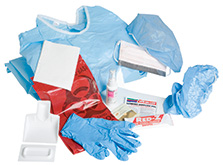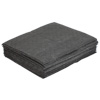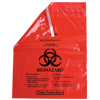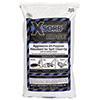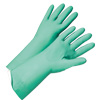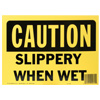Spill Control Program Standards
Spills, leaks, drips, and other similar wet conditions create a slip and fall hazards that can lead to serious injury and even lawsuits. It's essential that you have a spill control program for your property or facility.
Develop a written spill control program and train employees on their roles and responsibilities to keep everyone safe while also meeting Occupational Safety and Health Administration (OSHA) requirements.
Spills and OSHA Compliance
OSHA standard 29 CFR 1910.120 sets comprehensive requirements on what to do in the event of a spill.
If a worker can clean up a hazardous spill alone, then the spill would be considered incidental. Employees responding to an incidental spill need to be trained under the Hazard Communication (HAZCOM) standard 29 CFR 1910.1200.
An incidental spill control program may contain the following steps:
- Evacuate workers or anyone that could come in contact with the spill.
- Barricade the area with brightly colored caution signs.
- Wear appropriate personal protective equipment.
- Identify the spilled material.
- Contact the fire department if the spill is flammable.
- Contain and clean up the spill.
- Dispose of the spill in accordance with local, state, and federal regulations.
If an employer requires an employee to help control or clean up an emergency spill, and the spill is too large or difficult for a worker to clean up alone or if the substance is hazardous, then the spill would fall under OSHA's Hazardous Waste Operations and Emergency Response (HAZWOPER) standard.
There are also other emergency response requirements outside of HAZWOPER that should be followed if an employer does not require employees to respond to spills. Employers would be exempt from the HAZWOPER requirements if they provide an action plan in accordance with standard 29 CFR 1910.38.
Consult OSHA standards on specifics to follow in the event of emergency spills.
Reporting Hazardous Substance Release or Oil Spills to EPA
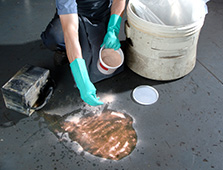
The Environmental Protection Agency (EPA) has a national hotline that is staffed 24 hours a day to receive reports of hazardous substance releases or oil spills.
In general, contact the EPA if the incident involves a release to inland areas or waters. The U.S. Coast Guard should be contacted for releases to coastal waters, the Great Lakes, ports and harbors, or the Mississippi River. EPA or the U.S. Coast Guard will relay release and spill reports to the National Response Center (NRC) promptly. The NRC can be reached at 1-800-424-8802.
Types of Spills and Absorbents
When faced with cleaning up a spill, the best type of absorbent material to use depends on what type of spill you have.
Typical maintenance leaks and spills may involve:
- Oil
- Grease
- Lubricants
- Petroleum-based solvents
- Fuels
- Water
- Antifreeze
- Bodily fluids
Sorbents can absorb and/or contain virtually any liquid found in the workplace. There are three categories of sorbents: universal, petroleum, and maintenance.
Universal sorbents absorb almost any liquid, including acids, bases, solvents, cleaners, water-based fluids, fuels, and alcohol.
Petroleum sorbents absorb oil and petroleum-based products.
Maintenance sorbents absorb liquids commonly found in manufacturing and maintenance operations.
These spill absorbents can come in the form of:
- Pads and rolls to catch leaks and drips
- Booms or socks to keep the area around machines clean and dry
- Pillows, which are useful for absorbing large amounts of liquids
- Loose sorbents to absorb liquids in heavy traffic areas
Additional Spill Equipment
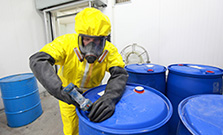
Personal Protective Equipment (PPE) is required by OSHA standard 29 CFR 1910.120 to limit worker exposure. In general, PPE can include breathing apparatus, coveralls, hard hats, face shields, safety goggles, gloves, and protective suits. Learn More About Personal Protective Equipment.
Communication devices such as two-way radios and safety signs should be kept on hand to notify workers and other people in the area as to the status and hazard risk of spills.
Bloodborne Pathogens
If workers can reasonably anticipate coming in contact with blood or other potentially infectious materials, then employers must have a written Exposure Control Plan according to OSHA standard CFR 1910.1030.
OSHA's standard addresses items such as the following:
- Exposure control plans
- Universal precautions
- Engineering and work practice controls
- Personal Protective Equipment
- Housekeeping
- Laboratories
- Hepatitis B vaccination
- Post-exposure follow-up
- Hazard communication and training
- Recordkeeping
It's important to note that employers must provide control measures, such as personal protective equipment and puncture-resistant sharps containers to eliminate or minimize risks. Some of the most basic equipment used should include:
- Gloves
- Utility gloves
- Masks, eye protection, and face shields
- Gowns, aprons, and other protective clothing
- CPR mouthpieces
Housekeeping and laundry practices must be followed to keep facilities clean. OSHA requires employers to create a schedule for periodic cleaning and appropriate disinfecting. Contaminated laundry should be placed and transported in properly labeled or color-coded bags and containers.
As part of training and education programs, safety signage communicating the risks, hazards, and steps to take if exposure occurs should be on prominent display in an area where all employees can access it.
Shop Spill Control Products
NOTE: This information is a summary interpretation and was prepared as general reference material only. This summary is not authoritative as laws can be amended over time. For specific compliance requirements and updates, please refer to the actual code language and the statute or legal counsel.

